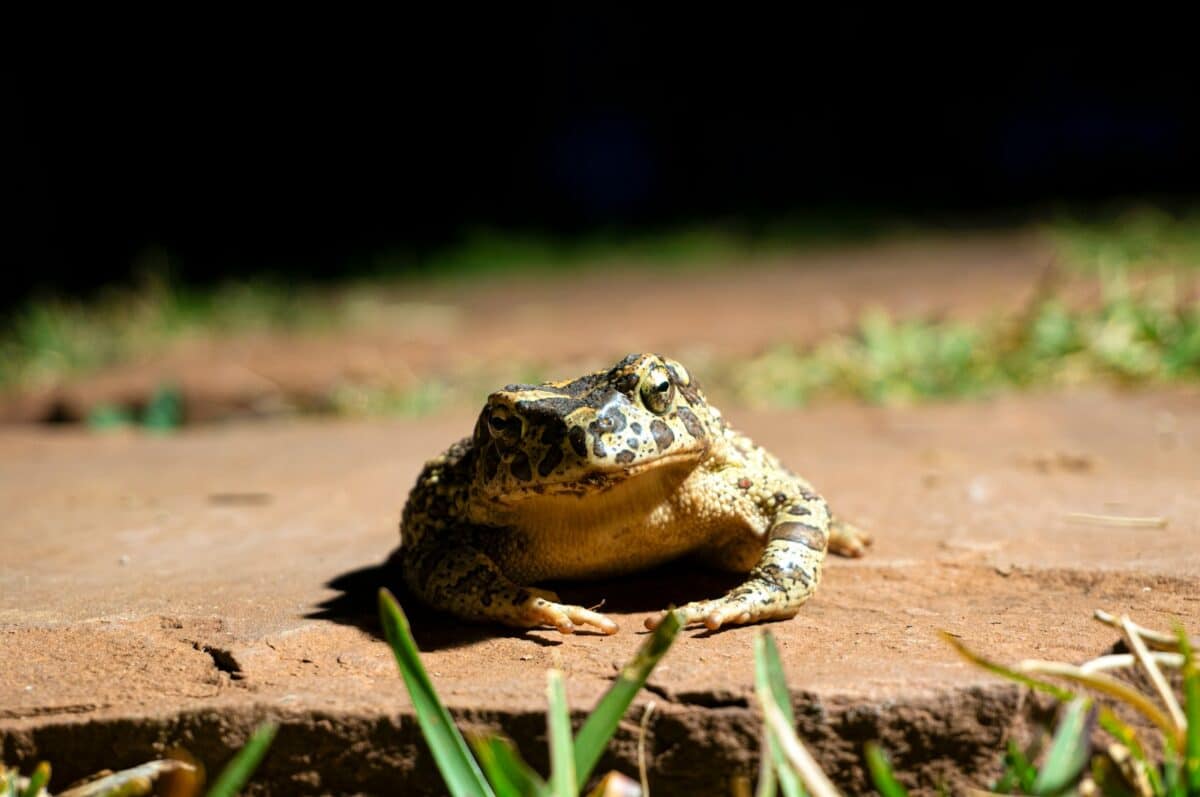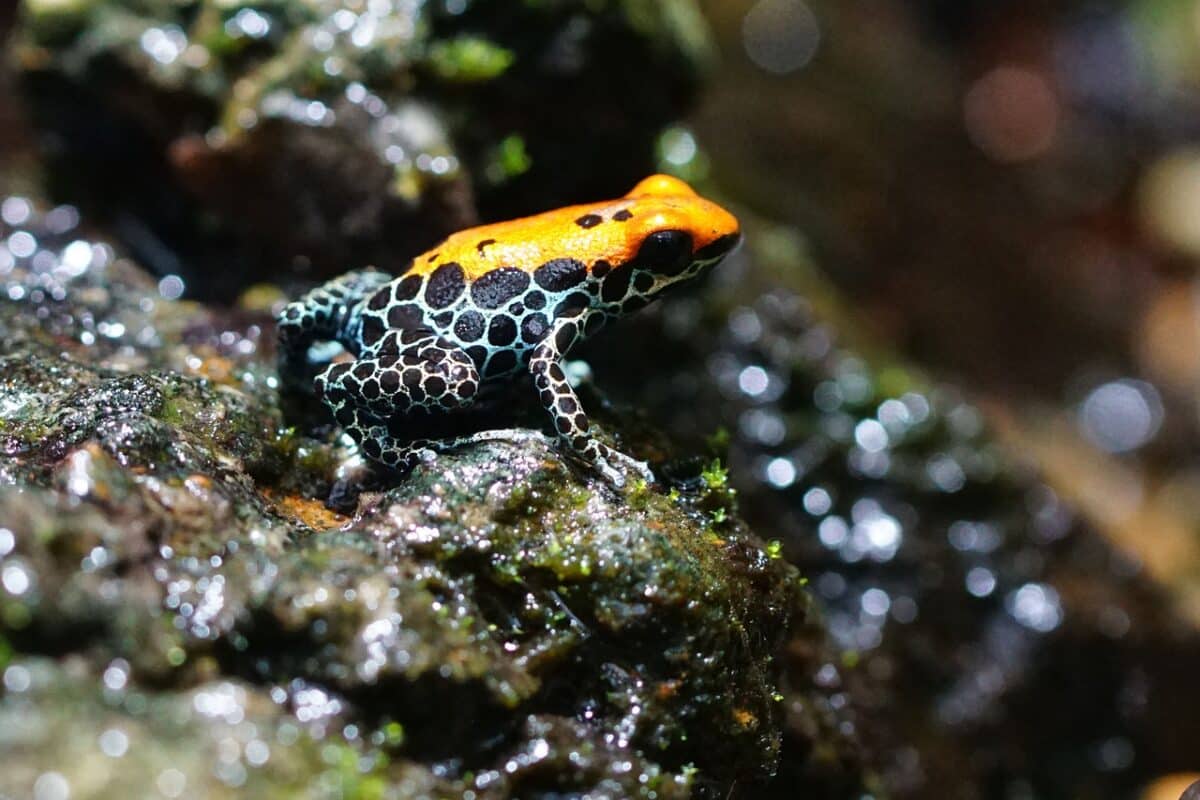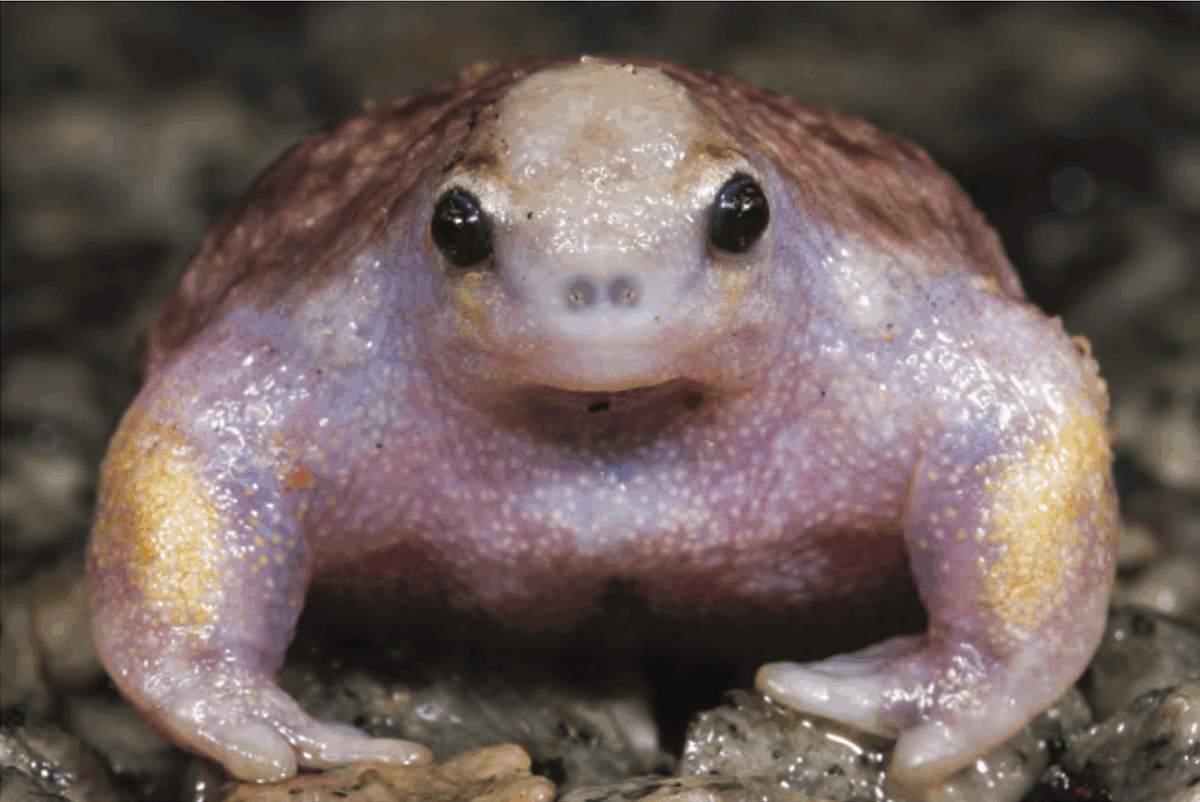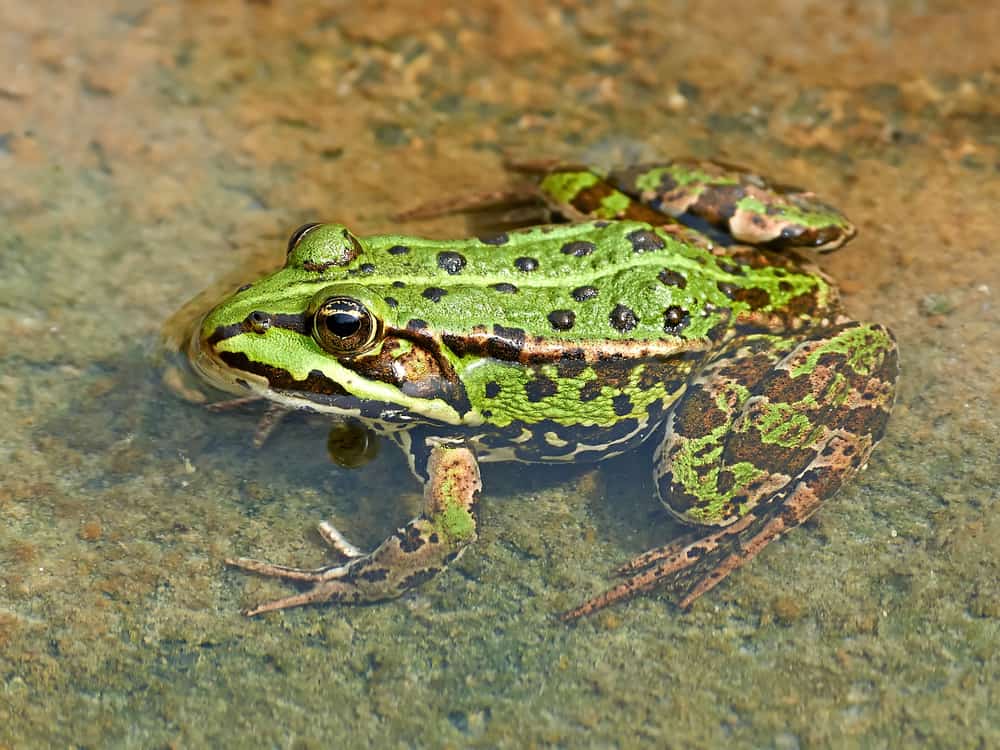Nature has an incredible way of surprising us with its boundless creativity, and nowhere is this more evident than in the world of amphibians. Among these remarkable creatures, frogs stand out for their astounding diversity of shapes, colors, and adaptations. While many people might picture a typical green frog when thinking about these amphibians, the reality is far more fascinating. Our planet hosts a remarkable array of frogs that defy conventional expectations, sporting bizarre appearances that seem almost otherworldly. From transparent skin to leaf-like appendages, horn-like protrusions to bubble-like bodies, these extraordinary amphibians push the boundaries of what we think is possible in nature. Let’s explore twelve of the most unusual, weird, and wonderful frogs from around the world that might leave you wondering if they’re actually real.
11. The Glass Frog (Centrolenidae)

Glass frogs earn their name from their most distinctive feature—translucent skin that reveals their internal organs. Native to the humid mountains of Central and South America, these small amphibians (typically measuring just 1.2 to 3 inches) display a remarkable biological transparency. Their ventral skin is so clear that you can observe their beating hearts, digestive tracts, and even bones without any special equipment. This unique characteristic is most pronounced in the Northern Glass Frog (Hyalinobatrachium fleischmanni), where the heart and liver are clearly visible through their lime-green dorsal skin.
Scientists believe this transparency might serve as an advanced form of camouflage. When sitting on leaves with light filtering through the forest canopy, glass frogs blend perfectly with the dappled light patterns, effectively “disappearing” from predators’ sight. These nocturnal creatures also display fascinating parenting behaviors—males guard egg clutches that females attach to leaves hanging over streams, ensuring that newly hatched tadpoles drop directly into the water below. With approximately 150 known species of glass frogs, these remarkable amphibians continue to astonish researchers with their evolutionary adaptations.
10. The Purple Frog (Nasikabatrachus sahyadrensis)

The Purple Frog, also known as the Pig-nosed Frog, represents one of the most peculiar amphibians discovered in recent times. First formally described in 2003, this living fossil has actually been evolving independently for nearly 130 million years. Endemic to the Western Ghats of India, this strange-looking amphibian spends most of its life underground, emerging only for a few weeks during the monsoon season to breed.
With its bloated, pig-like body, tiny eyes, and distinctive pointed snout that resembles a pig’s nose, the Purple Frog bears little resemblance to conventional frog species. Its body ranges from purple to grayish in color and can grow up to 9 centimeters in length. The frog’s peculiar physiology is perfectly adapted to its subterranean lifestyle—powerful forelimbs for digging, a rounded body shape for moving through soil, and specialized mouthparts that allow it to feed primarily on termites and ants. Unfortunately, this extraordinary amphibian faces significant threats from habitat destruction and is currently classified as endangered. Its unusual appearance and secretive habits make it one of the most peculiar frogs in existence, providing a glimpse into ancient amphibian evolution.
9. The Surinam Toad (Pipa pipa)

Perhaps one of the most unsettling amphibians on our planet, the Surinam Toad presents a biological horror show that challenges our perceptions of normal reproductive processes. This entirely aquatic species, native to the Amazon Basin in South America, possesses a flattened, leaf-like body that can reach up to 20 centimeters in length. Its extraordinarily flat body, triangular head, star-shaped fingertips, and tiny eyes positioned atop its head create an alien-like appearance that hardly resembles a typical amphibian.
However, the truly bizarre aspect of the Surinam Toad is its reproduction method. During mating, the female releases eggs that the male fertilizes and then embeds into the spongy skin on the female’s back. The skin grows over these eggs, creating individual pockets where the embryos develop. After approximately 3-4 months, fully formed toadlets dramatically burst through the mother’s skin in a scene reminiscent of science fiction movies. This remarkable adaptation ensures greater protection for offspring during development but creates one of the most visually disturbing reproductive spectacles in the animal kingdom. Despite their odd appearance and reproduction, Surinam Toads are harmless to humans and play important roles in their aquatic ecosystems.
8. The Desert Rain Frog (Breviceps macrops)

The Desert Rain Frog has achieved internet fame for a very specific reason—its surprisingly adorable squeak that sounds more like a squeaky toy than an amphibian call. Native to a narrow coastal strip between Namibia and South Africa, this round, pudgy frog has adapted to one of the most unusual environments for an amphibian—desert sand dunes. With its plump body, short limbs, and large, expressive eyes, this small frog (measuring only about 5 cm) has a distinctly cartoon-like appearance.
Unlike most frogs, the Desert Rain Frog doesn’t hop. Instead, it walks with short, deliberate steps or burrows into the sand using specialized feet with hardened tubercles that function like miniature shovels. Its distinctive round body conserves moisture in the arid environment, while its translucent skin allows it to absorb water from morning fog—a critical adaptation for desert survival. This species has evolved to live without standing water, relying instead on the fog that rolls in from the Atlantic Ocean. Despite their comical appearance and endearing vocalizations, Desert Rain Frogs face serious conservation challenges due to diamond mining operations and habitat destruction in their limited range, earning them a Vulnerable status on the IUCN Red List.
7. The Hairy Frog (Trichobatrachus robustus)

The Hairy Frog, also known as the Horror Frog or Wolverine Frog, earned its multiple nicknames through two extraordinary adaptations. Native to Central Africa, particularly Cameroon, this medium-sized amphibian (up to 11 cm) appears relatively normal at first glance, but closer inspection reveals its bizarre features. During breeding season, males develop hair-like structures along their sides and thighs. These “hairs” aren’t actually hair at all but specialized skin extensions filled with arteries and veins that significantly increase the surface area for oxygen absorption, essentially functioning as temporary gills that allow the males to remain underwater for extended periods while guarding their eggs.
Even more astonishing is the frog’s defensive mechanism that inspired its “Wolverine” nickname. When threatened, this remarkable amphibian can deliberately break the bones in its own toes, pushing the sharp, claw-like bone fragments through its skin to create improvised weapons. After the danger passes, the bones retract and the skin heals. This extreme self-modification for defense is exceedingly rare in the animal kingdom and represents one of the most unusual adaptations found in any vertebrate. Local communities in Central Africa hunt these frogs for food, referring to them as “bush meat,” despite their rather intimidating appearance and defense mechanisms.
6. The Vietnamese Mossy Frog (Theloderma corticale)

A master of disguise, the Vietnamese Mossy Frog exemplifies nature’s capacity for extraordinary camouflage. Native to northern Vietnam, this medium-sized amphibian (5-8 cm) possesses a remarkable skin texture that perfectly mimics moss and lichen growing on rocks. Its warty, bumpy skin in mottled greens and browns, combined with irregular black spots, creates an uncanny resemblance to moss-covered stone. This elaborate disguise makes these frogs nearly invisible in their natural habitat of moss-covered rocky outcrops near mountain streams.
Beyond their remarkable appearance, Vietnamese Mossy Frogs have additional adaptations that enhance their survival. When threatened, they curl into a ball and play dead, further reinforcing their rock-like appearance. They possess sticky toe pads that allow them to climb vertical surfaces with ease, and they can inflate their bodies when frightened to appear larger or wedge themselves into tight crevices. Their natural habitat in the humid forests of northern Vietnam is increasingly under threat from deforestation and habitat destruction, placing pressure on wild populations. However, their striking appearance has made them popular in the exotic pet trade, where captive breeding programs have been relatively successful, helping to reduce collection pressure on wild specimens.
5. The Turtle Frog (Myobatrachus gouldii)

The Turtle Frog of Western Australia defies conventional frog anatomy with its peculiar body structure that more closely resembles a small turtle without a shell. This unusual amphibian has a round, compact body (up to 5 cm long), short limbs, a small head, and tiny eyes—creating a distinctly un-frog-like silhouette. Its smooth skin varies from pink to reddish-brown, completing its unique appearance that earned it its common name despite having no actual relation to turtles.
What makes the Turtle Frog even more remarkable is its specialized lifestyle. Unlike most frogs that require water for breeding, this species has adapted to the arid Australian outback by becoming a burrowing specialist that spends most of its life underground. Its body is perfectly designed for digging, with muscular arms, shortened digits, and a wedge-shaped head that allows it to move through sandy soils with remarkable efficiency. The frog emerges only after heavy rains, typically for just a few weeks each year, to breed. Even more unusually, it bypasses the tadpole stage entirely—females lay their eggs in underground chambers where the young develop directly into froglets within the egg capsules. This remarkable adaptation to Australia’s harsh desert environment represents one of the most specialized life cycles among amphibians.
4. The Bornean Flat-Headed Frog (Barbourula kalimantanensis)

The Bornean Flat-headed Frog made scientific headlines in 2008 when researchers confirmed it was the first known lungless frog—a stunning evolutionary adaptation previously unknown in the amphibian world. Native to the fast-flowing, cold rivers of Borneo’s rainforests, this aquatic frog has evolved to absorb all necessary oxygen directly through its skin, eliminating the need for lungs entirely. This adaptation allows the frog to maintain a dramatically flattened body profile (hence its name) that reduces water resistance and prevents it from being swept away in rapid currents.
Measuring up to 7 cm in length, this unusual amphibian has an extremely flattened body with a broad, flat head that gives it a pancake-like appearance when viewed from above. Its body is uniformly dark brown or grayish, with a granular skin texture and muscular limbs that help it navigate rocky riverbed environments. Scientists believe the frog’s lunglessness represents an extreme adaptation to its fast-flowing habitat—the absence of buoyant lungs helps it stay submerged more easily in oxygen-rich water. Unfortunately, this extraordinary frog is classified as endangered due to habitat destruction from logging, gold mining, and palm oil plantations that affect water quality in its limited range. Its unusual physiology remains a subject of ongoing research, as scientists seek to understand how vertebrates can evolve to function without such seemingly essential organs.
3. The Long-Nosed Horned Frog (Megophrys nasuta)

The Long-nosed Horned Frog, also known as the Malayan Horned Frog, appears to have stepped directly out of a fantasy novel with its extraordinary leaf-like appearance. Native to the rainforests of Southeast Asia, particularly Malaysia, Indonesia, and Thailand, this medium to large frog (up to 12 cm) possesses elongated, fleshy points above each eye that resemble horns. Its most distinctive feature, however, is its sharply pointed snout that extends well beyond its mouth, creating a leaf-like projection that perfectly mimics fallen forest debris.
This incredible camouflage is further enhanced by the frog’s overall triangular shape and brown, tan, or reddish coloration with various patterns that resemble decaying vegetation. Even the frog’s behavior supplements its disguise—it remains motionless for long periods, blending seamlessly with the forest floor until prey comes within striking distance. When threatened, rather than fleeing, the frog often gapes its enormous mouth to appear more intimidating while producing a high-pitched scream. Female Long-nosed Horned Frogs grow significantly larger than males and lay their eggs in shallow, slow-moving streams where the tadpoles develop. Like many rainforest specialists, these remarkable amphibians face population challenges due to ongoing deforestation throughout their range, though they remain relatively common in protected areas with intact forest habitat.
2. The Ornate Horned Frog (Ceratophrys ornata)

The Ornate Horned Frog, commonly known as the Argentine Horned Frog or Pacman Frog, has achieved widespread recognition for its cartoonish proportions and voracious appetite. Native to the grasslands and rainforests of Argentina, Uruguay, and Brazil, this large amphibian (up to 15 cm) possesses a mouth that can occupy nearly half its body width and a body that appears almost perfectly circular when viewed from above. Its most distinctive features are the fleshy horn-like projections above its eyes, which enhance its already formidable appearance.
These frogs earned their “Pacman” nickname due to their remarkable similarity to the video game character—round bodies with enormous mouths that seem capable of consuming anything in their path. This comparison isn’t far from reality, as these ambush predators will attempt to eat nearly anything they can fit in their mouths, including insects, small rodents, reptiles, other frogs, and even small birds. Their hunting strategy is simple but effective—they remain motionless, camouflaged against the forest floor, then launch a lightning-fast strike when prey wanders too close. Ornate Horned Frogs are equipped with small tooth-like structures called odontoids in their lower jaws that help secure struggling prey. In captivity, these frogs have become popular exotic pets due to their distinctive appearance and relatively undemanding care requirements, though wild populations face pressure from habitat loss and collection for the pet trade.
1. The Titicaca Water Frog (Telmatobius culeus)

The Titicaca Water Frog, sometimes called the “scrotum frog” due to its excessively baggy skin, represents one of the most unusual aquatic adaptations in the amphibian world. Endemic to Lake Titicaca, which straddles the border between Peru and Bolivia at an elevation of 3,812 meters (12,507 feet), this large frog (up to 20 cm) has evolved to thrive in the cold, oxygen-poor waters of the world’s highest navigable lake. Its most remarkable feature is its loose, excessive skin that hangs in folds around its entire body, creating a wrinkled, baggy appearance unlike any other amphibian.
This extraordinary skin adaptation serves a critical physiological function—it dramatically increases the frog’s surface area for absorbing oxygen directly from the water. Unlike most frogs that frequently surface to breathe air, the Titicaca Water Frog conducts nearly all gas exchange through its skin, performing constant push-up movements underwater to circulate oxygen-depleted water away from its body. This specialized adaptation allows it to remain permanently submerged in the lake’s cold waters. Sadly, this unique frog faces critical endangerment from multiple threats, including pollution, over-harvesting for supposed medicinal properties and food, and introduced trout that prey on juvenile frogs. Conservation efforts are underway to save this extraordinary evolutionary specialist from extinction, including captive breeding programs at several international zoos.
Conclusion:

The incredible diversity and bizarre adaptations of frogs highlight nature’s unmatched ingenuity and the complex evolutionary paths life can take. From the translucent-skinned Glass Frog to the lungless Bornean Flat-headed Frog, and from the claw-wielding Hairy Frog to the skin-breathing Titicaca Water Frog, these amphibians defy our expectations of what a frog should be. Each species represents a unique survival strategy, tailored to thrive in environments as varied as cloud forests, deserts, and high-altitude lakes. While their strange appearances may seem otherworldly, they are vital parts of their ecosystems and offer valuable insights into evolution, adaptation, and biodiversity. As we continue to explore and understand these extraordinary creatures, we are reminded of the importance of preserving their habitats and ensuring that these natural wonders continue to amaze future generations.
- 14 Creatures That Can Freeze and Thaw Back to Life - August 9, 2025
- 10 Animals That Risked Their Lives to Save Humans - August 9, 2025
- 14 Reasons Why Bears Are Afraid of Humans (Most of the Time) - August 9, 2025

